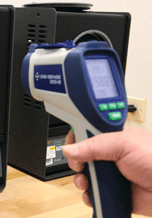Infrared technology is exploding in the various ways it is used and its future potential. From assessing heat leakage in homes to crime-fighting surveillance to healthcare applications, this technology is continually expanding to meet more and more needs. Recently, Phys.org even reported that “the government’s long-term goal for infrared technology is to remotely detect the exact materials, chemicals and gases coming and going from factories or other sites suspected of illegal nuclear production.”
With such important aspirations, it is paramount to keep infrared instruments functioning well. Even if you use your infrared thermometer for food preparation or diagnostics and inspection, you need reliable readings to make the correct adjustments.
To depend on the readings that appear on infrared displays, the instruments must be calibrated at regular intervals to NIST- traceable standards. NIST establishes the scales for transmittance, reflectance, and emittance of materials in the infrared spectral region and maintains absolute radiometric scales, among other objectives of their Infrared Technology Group.
Whether you use a thermal imager, infrared calibrator, or infrared thermometer, the technicians calibrating these instruments should have specialized training in infrared measurements. Leading calibration laboratories, such as InnoCal, employ trained metrologists who use radiometrically calibrated gray-body calibrators to correct for emissivity and heat loss uncertainties.
For infrared technology, make sure your instrument readings are as accurate as they should be. You never know how you will use this versatile technology next.
InnoCal calibrates infrared thermometers, infrared pyrometers, infrared calibrators, infrared transmitters, thermal imagers, and visual infrared thermometers. For more information, contact us.